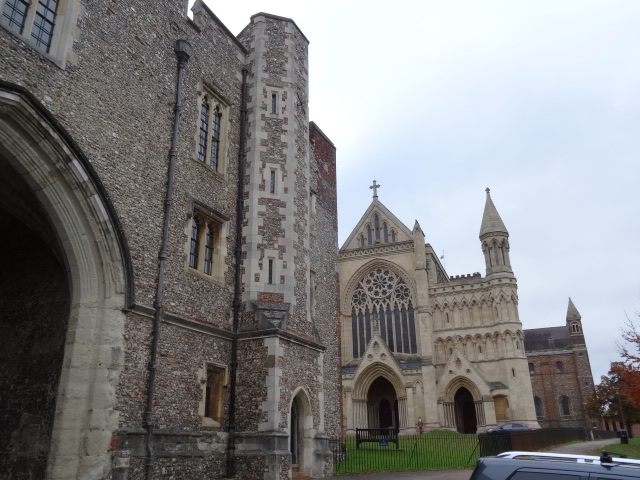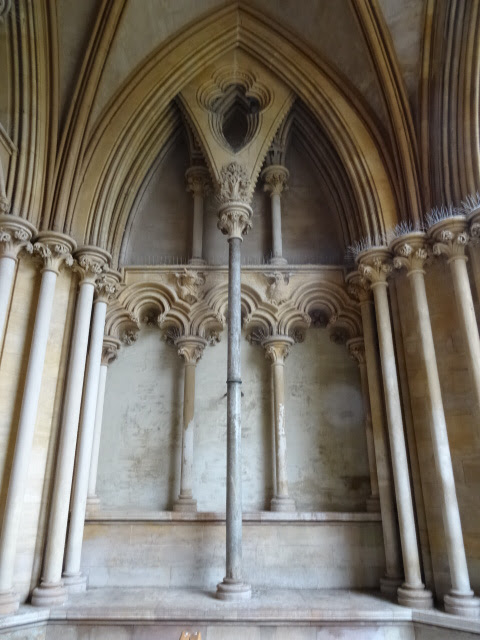On that trip to London late last year I had a welcome return to Cambridge. It was a Saturday and the city was incredibly busy. The train north from King's Cross packed. Cafes queued out. I wandered around the familiar streets in search of old favourites, old haunts, wary of change.
Monday 31 January 2022
Tuesday 25 January 2022
St Albans Cathedral I: The Exterior
I really must apologize for the tardiness of this post it is nearly two months since I took the Thameslink train north from St Pancras to St Albans. I am not over the effects of Lockdown. Anyway I was in London for the annual TAG Awards and pre-Christmas party. A catch up with friends. I took the opportunity to have a weekend away from the Infernal City. I hadn't been St Albans in years, decades when I think about it. At the time the city made little impression on me. However the old centre is very attractive, and there is much to enjoy with street after street of pre-modern houses - George St is particularly fine. And there are the remains of the Roman town of Verulanium. However St Albans both benefits and suffers by its proximity to London. Housing is very expensive and it is inordinately busy and congested. But at least it's not like Reading.
This post was originally going to begin with: 'Poor old St Albans, in turn abbey, parish church and finally cathedral, has suffered so much and so repeatedly in its long history.' Which sounds dramatic and, I hope, intriguing, but isn't really that accurate. Other cathedrals and greater churches have suffered more: Lichfield, for instance, was in ruins at the end of the English Civil War. In Wales the cathedrals of St David's and Llandaff were themselves largely ruinous by the mid-nineteenth century. So St Albans is no means unique in having a rough time of it after the Reformation. At least it stayed roofed and relatively intact at time when it must have been difficult for the congregation to pay for the upkeep for what is a vast building. And oddly parochial it still feels for such a large and important building - for St Albans has one of the oldest and most continuous histories of any church in the British Isles. It stands long and low, atop Holmhurst, now Holywell, Hill, almost shorn of context, overlooking the valley of the Ver, on the site traditionally associated with the Protomartyr Alban's passio. Depending on who read that event has been placed anywhere between 205 and 305AD, though the money these days is on the middle of that range, that is during the reigns of either the Emperors Decius or Valerian. Contemporary scholars tend also, I think, to believe that the Cathedral marks not the site of the martyr's execution but his grave and later his cella memoria in an area known to have contained a Romano-British cemetery. Either way it is a place of considerable historic importance and continuity. Tantalising.
The current building dates back from the time of the Paul of Caen, 14th abbot of the monastery. The massive central tower dates from this period and like the rest of Paul's monastic church is constructed of spolia, that is material garnered from the ruins of Verulamium down in the valley, in this case mainly bricks. It is this use of spolia that makes for crude and powerful architecture. Barbaric splendour, if you will, commensurate with the martyr's Antiquity, his Romanitas. It is also some of the earliest Norman work in the country. So we are lucky to have retained it.
One of the richest abbeys in England St Albans was, apparently, inept at managing its finances so that it was never wholly rebuilt which allowed for the retention of the Norman central tower. And then came the Reformation. The Abbey church became parochial, the monastic buildings with the exception of the Great Gate demolished, and the town took on the almost unequal struggle of maintaining such a vast building. But survive it did, only, in the late nineteenth century to run into Edmund Beckett, 1st Baron Grimthorpe. Lawyer and 'controversialist' Beckett was rich, domineering and an amateur architect who volunteered both his money and his meagre talents in the continuing restoration of the church when Sir George Gilbert Scott died in 1878. It was, I suppose, an offer that couldn't be refused, but it was an unequal match and a lot of damage done, texture lost.
The result is a rather odd patchwork of materials and styles. It lacks that cohesiveness and sublimity that one associates with cathedrals. It is a muted presence in the city. We are back to that sense of the parochial. From the west the tough, majestic tower is engaged in a uneven struggle with the inordinate length of the nave. Grimthorpe to his credit did, I think, realise this but his west front does little to address the aesthetic problem. I should add here that the west front does contain three Early English porches, which though heavily rebuilt are very stylish, sophisticated pieces of architecture. Gilbert Scott thought very highly of them. That said the w front seems almost completely disengaged with what it is going on behind. To get a better sense of the massive scale and vaulting ambition of Abbot Paul it's best to go down either Waxhouse Gate, or Sumpter Yard, where the tower looms over transepts and presbytery.
The underlying reason for this lack of 'cathedralness', lies in the the geology. Hertfordshire possesses no good building stone. There is chalk but that is really not suitable for exterior work. It weathers far too easily. And there is flint. The nearest good hard wearing freestone is available from the Limestone Belt and that would make is expensive to transport, and that is why the Norman builders resorted to spolia and why, I suspect, the work of later abbots was always so tentative.













